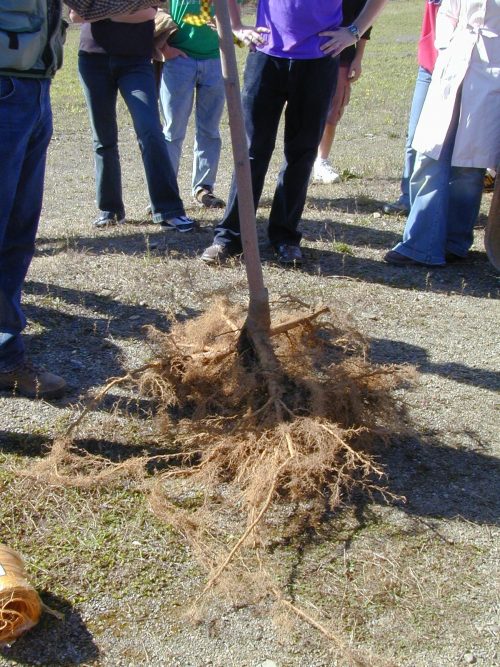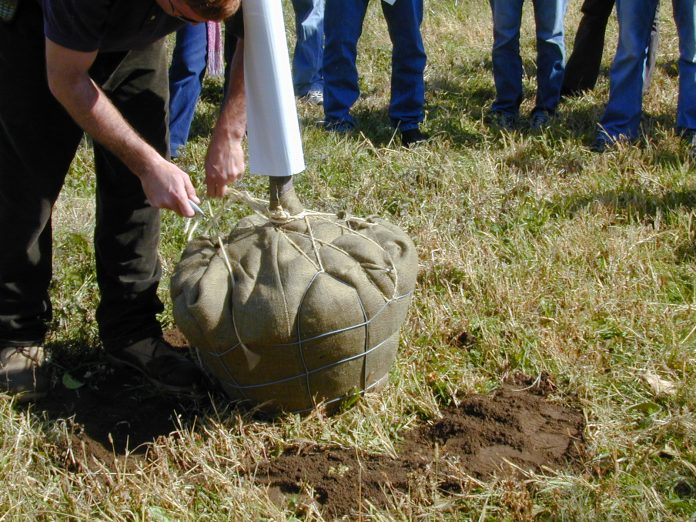Dr Nina Bassuk from the School of Integrative Plant Science discusses the importance of transplanting in urban tree establishment
Seemingly the most obvious and simple process in urban tree establishment is actually planting the trees. But there is more to this activity than putting the roots down and the leaves up.
Many municipalities are focusing on urban tree planting initiatives to reap the ecosystem benefits of trees in our cities. These include storm water reduction, water infiltration and purification, energy conservation from cooling buildings and pavement, increasing carbon sequestration in large trees, reducing air pollution and providing habitats for pollinators. To achieve all these benefits, the trees have to be healthy and grow to their envisioned size. We have developed a 4-step process to help insure successful tree establishment and growth no matter where the plantings are occurring.
- First we analyze site constraints or opportunities for tree growth on the proposed planting site. Is the soil healthy? Can sufficient water penetrate the pavement? Is there reflected heat from built surfaces causing trees to lose water faster? These issues among others are key to deciding which tree will do well on the site.
- Secondly, tree selection including species, form, longevity, hardiness to winter and summer temperatures, pest resistance, and tolerance of various site conditions is the next step in the establishment process. Although there have been several commonly grown and over planted urban tree species, the focus is now on increasing the diversity of species to create more ecosystem benefits and as a hedge against a catastrophic pest infestation that could wipe out an entire species, such as occurred when Elm trees succumbing to Dutch Elm Disease. The more thorough the site analysis the greater the potential for diversifying tree species.
- The third step is site optimization, which often means improving soil conditions and available soil volume. Tree roots must compete with pavement and underground utilities and encounter the aftereffects of development and construction. These ubiquitous urban activities often compact the soil making it inaccessible for root growth.
- The final and often overlooked fourth step, is careful tree transplanting and initial care.

The first growing season after tree transplanting is a critical period. Despite the addition of supplemental water, trees often grow poorly or may even die . This phenomenon, called ‘transplant shock’ encompasses many features including delayed bud break, smaller leaves, minimal stem elongation and increased susceptibility to water deficits. While supplemental water does not negate transplant shock, the lack of water after transplanting can exacerbate the issue. If trees do survive, they often take two or more years to out-grow this period. Although all trees experience some level of transplant shock, certain species have been shown to be more sensitive to transplant shock and are therefore more susceptible to premature death.
The nursery and landscape industries have few options to remedy such transplanting problems. Subsequently, tree species that may have potential in the urban landscape are frequently omitted because they do not transplant readily. This trend ultimately reduces the diversity of viable species of nursery crops and promotes a market that favors easily transplantable trees. This bottleneck of species diversity in the nursery and subsequent availability largely dictates the composition of species diversity in managed landscapes with direct ramifications for their resilience to biotic and abiotic pressures.
We believe that there are five major interacting factors influencing transplanting success: season of digging, species, production method, size, and aftercare. Season is best understood in its interactions with the other factors, while the essential nature of good aftercare (watering, weeding, mulching, avoiding damage to bark, etc.) is obvious.
Species and seasons
Species and season of transplanting has been observed to affect the success of transplanted trees in some species. In temperate regions, late winter or early spring planting prior to the new growth is considered optimum for achieving transplant success in difficult to transplant trees although there is evidence that fall planting can also be successful.
Many nursery professionals have ‘fall hazard’ transplanting designations for species that have been observed to fail after fall planting.
Those fall hazard tree planting lists are generalizations. Typically the trees that appear on those lists are trees that are more difficult to transplant, regardless of season. In spring they don’t become easy to transplant; they’re just observed to be easier in the spring than in the fall, but still might fail. We are currently investigating why some tree species are more difficult to transplant than others. It may have to do with the ability of a given species to maintain hydraulic conductivity, the uptake of water by avoiding cavitation (obstructing bubbles in the xylem) after its roots are severed.
Why is bur oak (Qurcus. macrocarpa) so difficult to transplant while its close relative, swamp white oak( Quercus bicolor), is relatively easy? Our early results show that bur oak isn’t able to take up significant water from its severed root system after transplanting. Water uptake is compromised until it makes new roots. Inadequate adequate water at planting and thereafter exacerbates the problem. Meanwhile, swamp white oak can take up water from its own root system after transplanting; it has better hydraulic conductivity than bur oak.”
Production method
Bare-root digging harvests exponentially more roots along than does balled and burlap (B&B) digging. For many species, if bare root trees are handled properly, they may exhibit higher survival in spring or fall because of this larger root system. For notoriously difficult-to-transplant species however, container-grown trees are actually the safest bet, because the entire root system is brought along and there is no root severing to trigger cavitation. However, container-grown trees of the species and size arborists desire are not always readily available.
Size: In terms of transplanting, for both B&B and bare root, the larger the caliper of tree, the poorer the transplanting result. Bare root trees above 2-inch( 5 cm) caliper are especially at risk. For instance, even though spring planting works better for bur oak, with larger caliper trees there are high rates of failure, even in spring and in the best conditions.”
This is because the larger the tree caliper at transplanting, the greater the percentage of its roots are lost in digging from the nursery; it takes a longer time for a root system to grow to support that larger canopy than it does to support a smaller canopy. In our experience, size trumps season and species and production method.. For this reason, we recommend that arborists, whether in spring or fall, consider planting B&B and bare root trees at 2-inch caliper or less; research shows that smaller trees have higher establishment rates and catch up with or even outgrow their larger-caliper, more stressed counterparts.
In our work in New York and with dozens of other municipalities, We have found that smaller bare root trees, have been successfully fall-transplanted even though many of the trees frequently appear on fall hazard lists—including London planetrees, goldenraintrees, crabapples (Malus spp.), zelkovas, cherry trees, pear trees, oaks, and elms. Transplanting success will depend on season, species, production method and size of the tree. Ultimately, growing and harvesting techniques that maximize improved hydraulic conductivity in newly planted trees will provide the best result.








